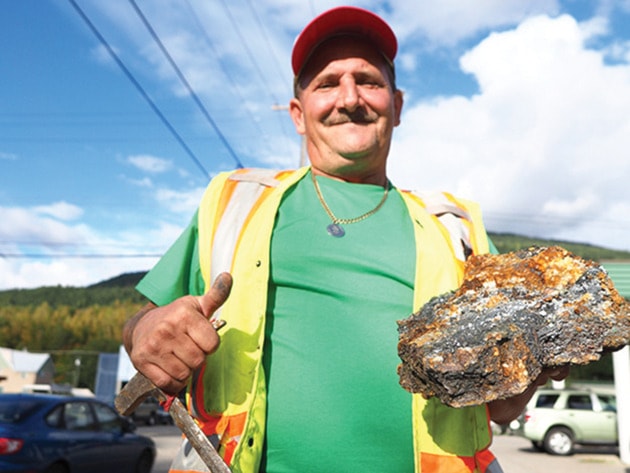By Alex Cooper
BLACK PRESS
Darrel Davis has struck gold. Literally.
The Trout Lake miner from Salmon Arm, who runs his own exploration company, Davis Mining & Exploration Corporation, burst into my office last week with news of what he called a “staggering” find from his mining claims on Silvercup Ridge.
He showed me test results from Activation Laboratories in Kamloops that showed samples with up 200 grams of gold per ton (g/t), or 6.2 ounces per ton.
“To find an ounce per ton of gold in hard rock is almost unheard of these days,” he told me. “To find one at 6.2 ounces is staggering at best. I still don’t know what to do and I’ve been in this all my life.”
Davis grew up in Trout Lake and worked in the mines on Silvercup Ridge when he was in school. He has no formal education but instead has learned the trade by working and talking to professional geologists. He says he’s been in the exploration game for 35 years and has made several discoveries he was able to sell off to big mining companies.
“I’ve worked for many major mining companies and there are not that many prospectors that are still around that fund their own work and do this kind of thing,” said John Gardiner, the CEO ofTaranis Resources, which is exploring several claims north of Davis’. “He’s one of them. He’s a pretty determined guy.”
Davis’ finds come from the Winslow claim, which is located in an alpine area of Silvercup Ridge that overlooks Trout Lake. According to a report by the BC Geological Survey, the claims were mined heavily from about 1904 to 1915, and only periodically since then.
Davis had his eye on six Crown grants that dated to the original exploration more than a century ago, and he purchased them about 1.5 years ago.
“I always knew about this mine but I couldn’t do anything because I didn’t own it,” he said.
Once they were his, he hired an excavator to dig around the original mines, which is where he made his strike.
According to the report by Activation Laboratories, three of six assays from the Winslow claim returned strong results for gold – 56.6 g/t, 136 g/t and 200 g/ton. “I don’t think there’s been a mine in all of southern B.C. in 75 years with assays even close to this,” he told me.
I have been unable to substantiate that claim.
Davis’ samples come from close to the surface. He says he took them at two-foot intervals, but he didn’t dig down deep. They were sent to the laboratory for testing.
Gardiner advised caution in writing about the results. “They are very high grade gold results. How big it is remains to be seen,” he said. “That’s going to take some drilling. It’s going to take a lot more work to assess the size of it.”
What happens now?
I receive many news releases from junior mining companies announcing the results of their digging. They look for mineral deposits, hoping to strike it rich by selling them off or turning them into full-fledged mines.
Developing a gold deposit is very challenging. Big mines contain only a few grams of gold per ton, meaning massive amounts of ore must be mined to make them viable. According to the World Gold Council, only 10 per cent of global gold deposits have enough gold to actually mine.
As far as discoveries go, Davis’ sample results are high. For example, Gardiner’s company, Taranis Resources, recently announced discoveries of 52.4 g/t and 30.6 g/t of gold.
“The rock he showed me was really nice. You could see the visible gold in it. It looked identical to something we found on our property in 2013,” said Gardiner.
The big question is how widespread the gold deposit is and what kind of interest it will attract. Davis said he’ll have a few options. He can rent some equipment and process the claims himself. He can also try to sell the claims to a mining company, who can do more exploration and determine if its viable to turn it into a large-scale operation. He can sell it outright and take the money up front, or he can come up with an agreement that will see if he gets royalties on all the gold mined if it ends up being productive.
“I don’t know whether to let a company get involved or to have some people in my family process the ore,” he said.
Gardiner said it would take more drilling to determine the viability of the mine. He did say the results got his interest and he’s hoping to look at the property in the spring.
“When districts show a lot of gold, it attracts a lot more interest than just silver,” he said. “It could be a renaissance for the area.”
